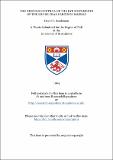Files in this item
The nervous control of the eye movements of the shore crab Carcinus maenas
Item metadata
| dc.contributor.advisor | Horridge, G. Adrian | |
| dc.contributor.author | Sandeman, D. C. | |
| dc.coverage.spatial | 144 p. | en_US |
| dc.date.accessioned | 2018-06-26T11:10:32Z | |
| dc.date.available | 2018-06-26T11:10:32Z | |
| dc.date.issued | 1964 | |
| dc.identifier.uri | https://hdl.handle.net/10023/14601 | |
| dc.description.abstract | 1. The eyes of the crab Carcinus follow with constantly increasing lag the movement of a horizontally rotating (but not a linearly translated) visual field during the slow phase of optokinetic nystagmus. The difference between the eye speed and the drum speed is the effective stimulus for optokinetic nystagmus, and the response bears a constant relation to the stimulus over four orders of magnitude. The lower limit of the response is due to the breakdown of neuromuscular, and not visual mechanism. 2. An overall feedback mechanism exists in which the movement of the eye reduces the apparent movement of the drum. The control of the eye movement is by way of visual cues and proprioceptors play no part. 3. A seeing eye, provided with the appropriate visual stimulus, will drive the other eye if the latter sees no contrasting objects in its visual field or is blinded. Clamping an eye so that it cannot move relative to a stationary, contrasting visual field has the same effect as surrounding the animal with a blank field. 4. The rapid return phase of optokinetic nystagmus also takes no account of proprioceptors, but seems to be triggered when the efferent impulses to the eye muscles reach a definite frequency. Blinding one eye or increasing the drum speed cause a delay of the fast phase. Both eyes flick back simultaneously and the impulses in the oculomotor nerve which cause the slow phase are inhibited during the fast phase. 5. The fast protective retraction of the eye into its socket is a reflex which can be elicited by mechanical stimulation of a single sensory hair. The eyes can retract independently and if retraction occurs during the slow phase of optokinetic nystagmus, the efferent impulses in the oculomotor nerve of the retracting side are centrally suppressed. Peripheral inhibition of the optokinetic response occurs in the retracted eye when it. Is retained in its socket after retraction while the other eye continues with the slow phase of optokinetic nystagmus.7. A comparison reveals similarities in the mechanism causing the onset of the fast phase of optokinetic nystagmus in the crab and in mammals. | en_US |
| dc.language.iso | en | en_US |
| dc.publisher | University of St Andrews | |
| dc.subject.lcc | QP485.S2 | |
| dc.subject.lcsh | Color vision | en |
| dc.title | The nervous control of the eye movements of the shore crab Carcinus maenas | en_US |
| dc.type | Thesis | en_US |
| dc.type.qualificationlevel | Doctoral | en_US |
| dc.type.qualificationname | PhD Doctor of Philosophy | en_US |
| dc.publisher.institution | The University of St Andrews | en_US |
This item appears in the following Collection(s)
Items in the St Andrews Research Repository are protected by copyright, with all rights reserved, unless otherwise indicated.

